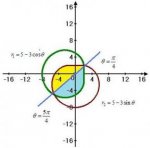shortman12012
New member
- Joined
- Aug 23, 2011
- Messages
- 8
Given the two polar equations r=5-3cos(θ) and r=5-3sin(θ) find the area of the region common to both curves.
So using the equation A= 1/2∫ r^2 dθ, the limits of integration I get by equating the two equations are θ= π/4, 5π/4. My question is am i setting this up all right and my equation to find the area is A = ∫(5−3cos(θ))^2 dθ + ∫(5−2sin(θ))^2 dθ. Can someone let me know if this is correct or what I'm doing wrong please
Also here is my graph

So using the equation A= 1/2∫ r^2 dθ, the limits of integration I get by equating the two equations are θ= π/4, 5π/4. My question is am i setting this up all right and my equation to find the area is A = ∫(5−3cos(θ))^2 dθ + ∫(5−2sin(θ))^2 dθ. Can someone let me know if this is correct or what I'm doing wrong please
Also here is my graph

